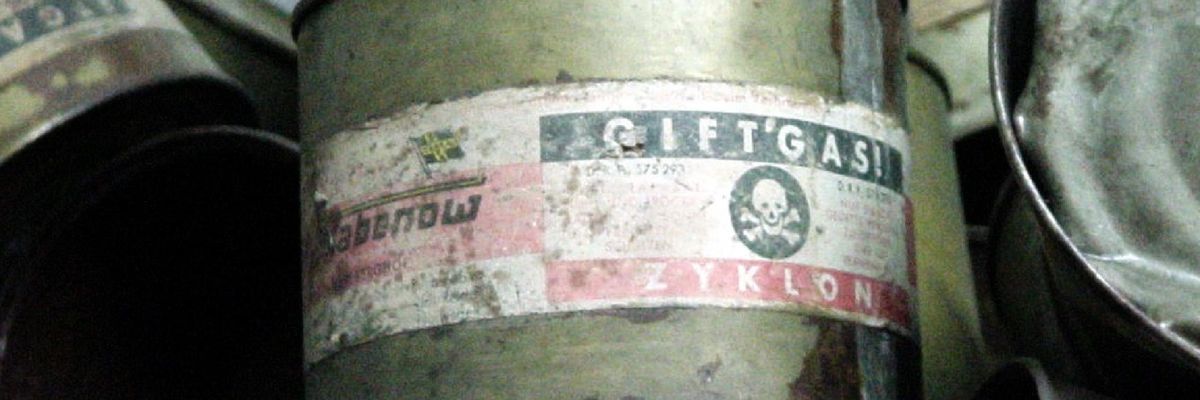Death penalty abolitionists have expressed shock in recent days following the revelation that Arizona officials are preparing to execute death row inmates using hydrogen cyanide, the same gas with which the Nazis killed over a million people during the Holocaust under the trade name Zyklon B.
"You have to wonder what Arizona was thinking in believing that in 2021 it is acceptable to execute people in a gas chamber with cyanide gas. Did they have anybody study the history of the Holocaust?"
--Robert Dunham, DPIC
Documents obtained by The Guardianshow that Arizona's Republican-controlled Department of Corrections, Rehabilitation, and Reentry (ADCRR) has spent $2,000 to obtain the materials needed to make cyanide gas, including a brick of potassium cyanide purchased last December for $1,530, as well as sodium hydroxide pellets and sulfuric acid.
The documents also revealed that the state's gas chamber at Arizona State Prison Complex in Florence--which was built in 1949 and hasn't been used to kill anyone in 22 years--has been "refurbished."
The Guardian called some of the techniques used to test the death chamber's efficacy "astonishingly primitive," including checking its air-tightness by lighting a candle and holding it up against a sealed door and windows.
The last Arizona gas chamber execution stands as a cautionary tale for death row inmates facing the choice of whether to die by gassing or lethal injection. In March 1999, Walter LeGrand, a German national, took 18 minutes to die as he suffered what an eyewitness described as "agonizing choking and gagging" in a cloud of cyanide vapor.
On April 6, Arizona Attorney General Mark Brnovich announced the state was ready to resume killing prisoners, and that he would ask the state Supreme Court to begin issuing execution warrants. Brnovich's announcement came a month after ADCRR said it had obtained a supply of the lethal injection drug pentobarbital. The Guardianreported in April that Arizona officials spent $1.5 million to acquire pentobarbital from an undisclosed source.
This single-drug execution method causes victims to endure "excruciating suffering, including sensations of drowning and suffocation," according to anesthesiology expert Dr. Gail Van Norman.
As Common Dreams reported at the time, the last inmate executed by lethal injection in Arizona took nearly two hours to die. Joseph Wood, who was killed in July 2014, gulped and snorted hundreds of times as 15 shots of an experimental mix of midazolam and hydromorphone coursed through his veins.
States have been accused of using condemned prisoners as human guinea pigs as they experiment with substitute lethal injection drugs amid growing refusal by companies to sell their products for use in executions.
Wood's botched execution prompted a temporary suspension of capital punishment in Arizona, as lawyers for condemned convicts and human rights defenders argued such killings violated the Eighth Amendment's prohibition of cruel and unusual punishment.
According to The Guardian, officials have selected two of Arizona's 115 death row inmates as likely candidates for killing once executions resume. Joseph Perkovich, an attorney for Frank Atwood, one of the candidates, told the paper that "neither option"--gassing or lethal injection--"is tenable." Perkovich said a discrepancy between the potassium cyanide obtained by corrections officials and the sodium cyanide called for under state execution protocol "is not a small detail."
"The specific compound is vitally important," he stressed.
Anti-death penalty campaigners have sounded the alarm over Arizona's plan to kill prisoners using the same gas with which the Nazis murdered (pdf) around 1.1 million people in extermination camps including Auschwitz.
"This is not justice--it's horrifying," the ACLU tweeted.
"You have to wonder what Arizona was thinking in believing that in 2021 it is acceptable to execute people in a gas chamber with cyanide gas," Death Penalty Information Center (DPIC) executive director Robert Dunham told The Guardian. "Did they have anybody study the history of the Holocaust?"

